In 2025, resolving technical SEO issues is critical for any business seeking top ranks, larger traffic, and boosted conversions. Whether you manage an e-commerce site, local business, SaaS platform, or publisher website, ignoring technical SEO errors can lead to crawlability problems, indexing failures, and visibility loss.
This detailed guide will assist you in identifying, understanding, and resolving the most frequent technical SEO errors. Optimized for GEO, AEO, SXO, and semantic SEO, this content aims to future-proof your site’s performance.
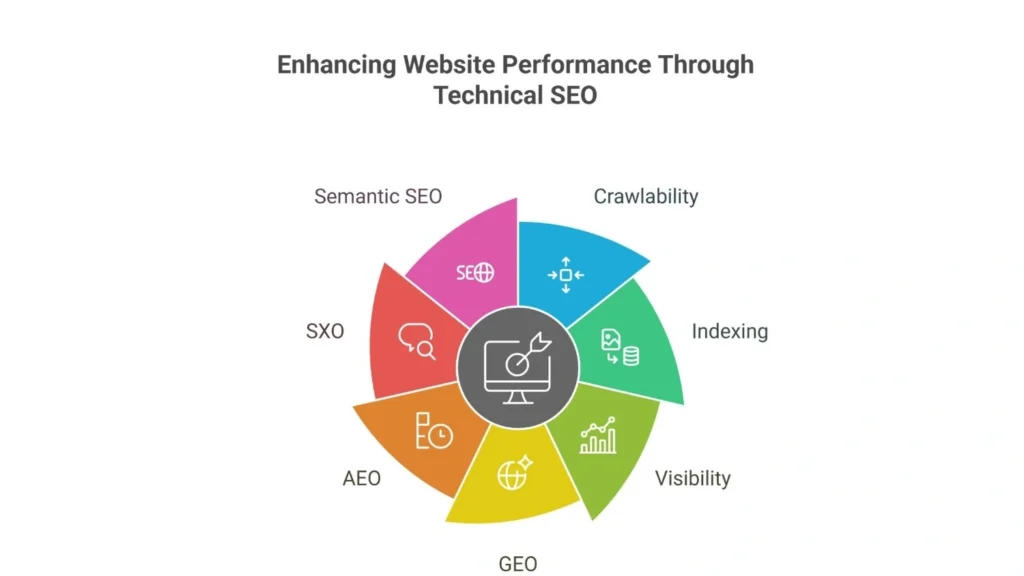
What Are Technical SEO Issues?
Technical SEO issues are structural and backend problems that prevent search engines like Google from effectively crawling, indexing, and understanding your website. These include issues related to site architecture, speed, mobile optimization, security, and structured data.
Technical SEO vs On-Page vs Off-Page SEO
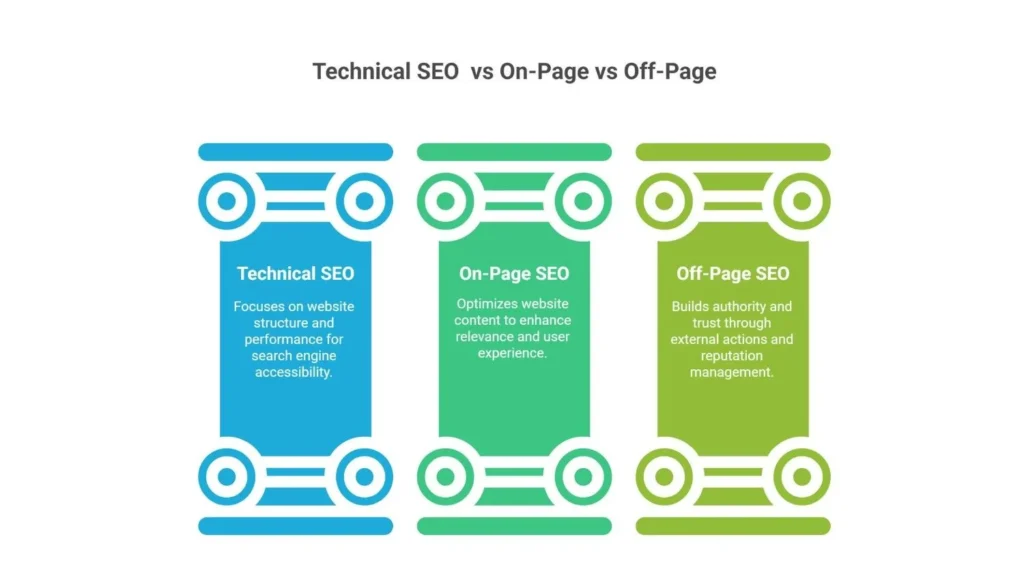
- Technical SEO: Enhancing the structure of your website to make it easier for search engines to crawl and index your content is known as technical SEO. It considers factors including server performance, XML sitemaps, HTTPS, structured data, and how quickly the website loads and functions on mobile devices.
- On-Page SEO: The main goal of on-page SEO is to optimize your website's content, including headers, internal linking, meta tags, multimedia, and keyword targeting. Its objective is to increase the relevance and value of your pages for search engines and users alike.
- Off-Page SEO: The main goal of off-page SEO is to establish authority and trust through actions that take place outside of your website. To increase your website's legitimacy in search engine results, this entails obtaining backlinks, controlling your online reputation, and utilizing social signals.
Why Fixing Technical SEO Errors Is Critical for Your Website?
If you disregard technical SEO issues, your website’s capacity to appear in search results may suffer significant damage. These issues may impact conversions, increase bounce rates, and decrease your chances of ranking.
Complications with technical SEO, such as sites that load slowly, broken links, or a lack of sitemaps, could hamper the development of your online presence.
Use cases:
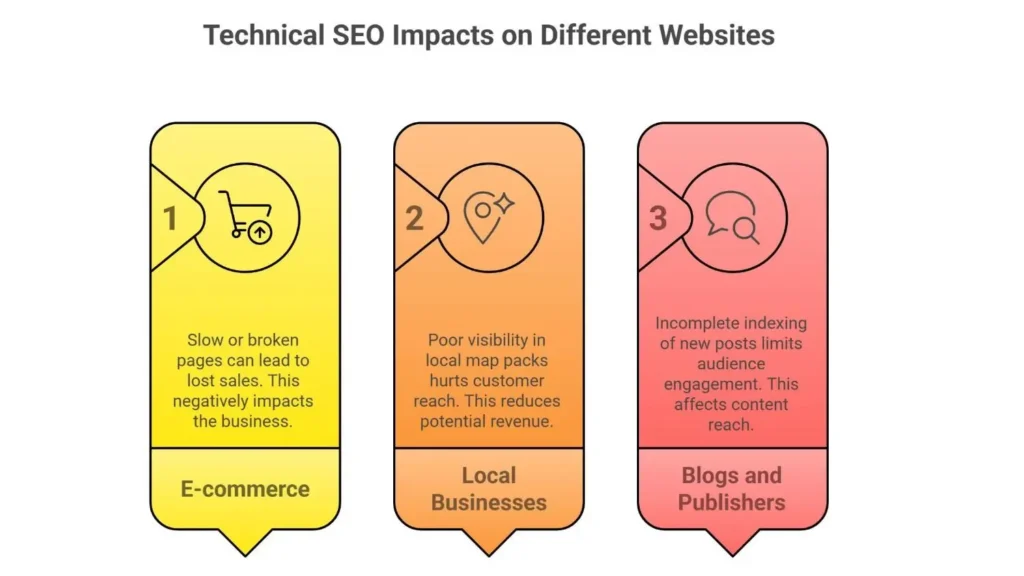
- E-commerce: Lost sales due to slow or broken pages.
- Local businesses: Poor visibility in local map packs.
- Blogs and Publishers: Incomplete indexing of new posts.
Top 12 Technical SEO Issues and How to Fix Them (2025)
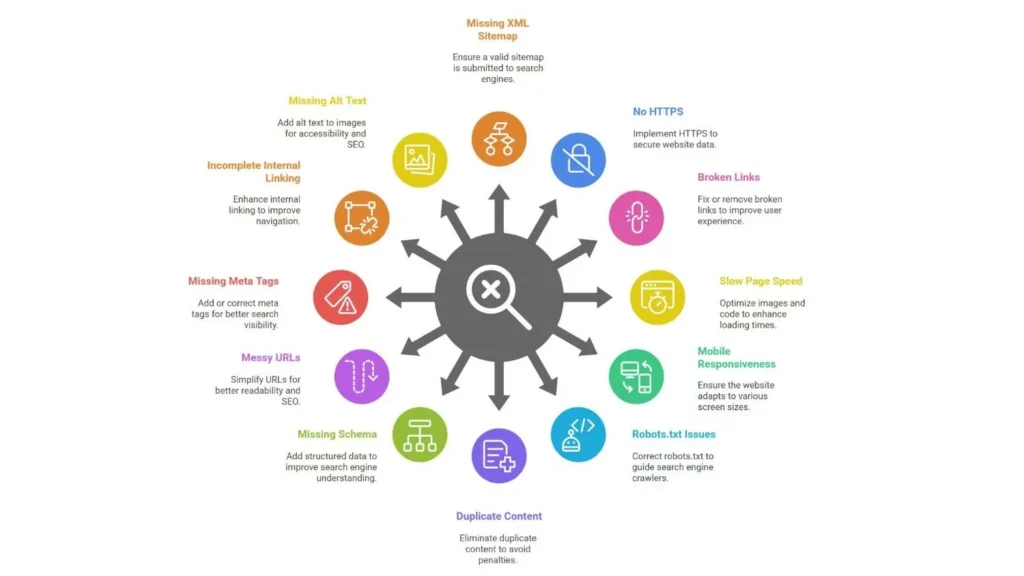
1. Missing or Invalid XML Sitemap
A file called an XML sitemap aids search engines in locating and comprehending all of your website’s key pages. If your sitemap is incomplete, out-of-date, or created wrongly, search engines could miss important pages, which would result in poor indexing and visibility.
To fix this issue:
- Ensure your sitemap is located at /sitemap.xml and includes all relevant URLs.
- Generate separate sitemaps for blog posts, products, images, and videos if necessary.
- Use tools like Screaming Frog, Yoast SEO, or Rank Math to create a valid sitemap.
- Submit the sitemap in Google Search Console under the 'Sitemaps' section.
2. No HTTPS or Mixed Content
HTTPS guarantees a secure connection between your website and the user’s browser. Without it, Google could deprioritize your site in search results, and consumers might get a “Not Secure” notice.
To secure your website:
- Install an SSL/TLS certificate using platforms like Let’s Encrypt or Cloudflare.
- Ensure all internal links and media assets are updated to HTTPS.
- Use tools such as Why No Padlock or Sitebulb to scan for mixed content.
3. Broken Links (404 Errors)
Broken links damage your reputation and waste crawl budget by directing visitors and search engines to nonexistent sites. An excessive number of 404 errors damages user experience and undermines search engine credibility.
To resolve broken links:
- Use Google Search Console under Index > Pages > Not Found (404) to identify issues.
- Perform a crawl using Ahrefs, SEMrush, or Screaming Frog to catch dead internal and external links.
- Redirect broken pages with 301 redirects to the most relevant live pages.
- Regularly audit and update your internal links.
4. Slow Page Speed (Core Web Vitals)
A slow website leads to frustrated users and lower rankings. Page speed is directly tied to Core Web Vitals: Largest Contentful Paint (LCP), First Input Delay (FID), and Cumulative Layout Shift (CLS).
To improve your site speed:
- Use PageSpeed Insights or GTMetrix to assess loading times and performance issues.
- Optimize and compress images to under 100KB where possible.
- Minify JavaScript and CSS files to reduce page load weight.
- Implement lazy loading for images and videos.
- Use a CDN and browser caching to speed up global delivery.
5. Mobile Responsiveness
With mobile-first indexing, Google uses the mobile version of your site for indexing and ranking. A non-mobile-friendly site will see reduced rankings, especially in mobile searches.
To enhance mobile usability:
- Use responsive design with CSS media queries to adjust layout for all screen sizes.
- Run your site through Google’s Mobile-Friendly Test.
- Optimize font sizes, tap targets, and navigation for small screens.
- Ensure fast loading on mobile devices with AMP (Accelerated Mobile Pages) if necessary.
6. Robots.txt Issues
The robots.txt file tells search engines what they can and cannot crawl. Misconfigurations can block important pages or resources, affecting indexing and SEO performance.
To fix your robots.txt file:
- Place it in the root directory (e.g., www.example.com/robots.txt).
- Don’t block essential resources like CSS or JavaScript files.
- Avoid using “noindex” directives in robots.txt.
- Use the URL Inspection tool in Google Search Console to test and validate the file.
7. Duplicate Content
Duplicate content confuses search engines and causes ranking dilution. If two or more pages are identical or nearly identical, Google may not know which to index or rank.
To manage duplicate content:
- To the recommended version of a page, add canonical tags.
- Use 301 redirects for outdated or moved duplicate pages.
- Perform audits using Copyscape, Siteliner, or Ahrefs.
- Avoid duplicating boilerplate content like disclaimers or product descriptions.
8. Missing Schema / Unstructured Data
Using structured data helps search engines better understand your content and display rich results in search — such as product details, star ratings, and FAQs. Without it, your site may miss out on enhanced visibility in search listings.
To add structured data to your site:
- Use Google's Structured Data Markup Helper to generate schema.
- Add schema types like Article, LocalBusiness, Product, FAQ, etc., depending on your content.
- Use JSON-LD format and insert it in the or before the tag.
- Validate your markup using Google’s Rich Results Test.
9. Messy or Dynamic URLs
Unclean URLs with query strings or random characters are hard for users to read and for search engines to understand. They may lead to problems with duplicate content and low CTR.
To clean your URLs:
- Use short, keyword-rich, and descriptive URLs.
- Avoid using session IDs, unnecessary parameters, or underscores.
- Implement canonical tags for URL variations.
- Stick to a logical and flat URL structure.
10. Missing or Duplicate Meta Tags
Short page headings and preview text are important for helping visitors and search engines understand your content. If these fields are missing or repeated, your pages might not perform well in search results.
To improve this:
- Write unique titles (50–60 characters) and descriptions (150–160 characters) for each page.
- Include primary keywords naturally.
- Use SEO plugins or tools to audit and update missing tags site-wide.
11. Incomplete Internal Linking
Without a strong internal linking structure, search engines may miss important pages and users may struggle to navigate. Orphan pages often remain unindexed.
To improve internal links:
- Link related blog posts, services, or products using contextual anchor text.
- Highlight cornerstone content across multiple relevant pages.
- Use a site crawler to find and fix orphan pages.
12. Missing Alt Text for Images
Alt text helps search engines recognize images and facilitates accessibility. Missing alt text results in lost SEO opportunities, especially in image search.
To optimize image alt text:
- Write descriptive alt tags that reflect the image's content.
- Naturally incorporate relevant keywords without stuffing.
- Audit your site using Screaming Frog or Sitebulb to find images without alt attributes.
How to Perform a Technical SEO Audit (Step-by-Step)?
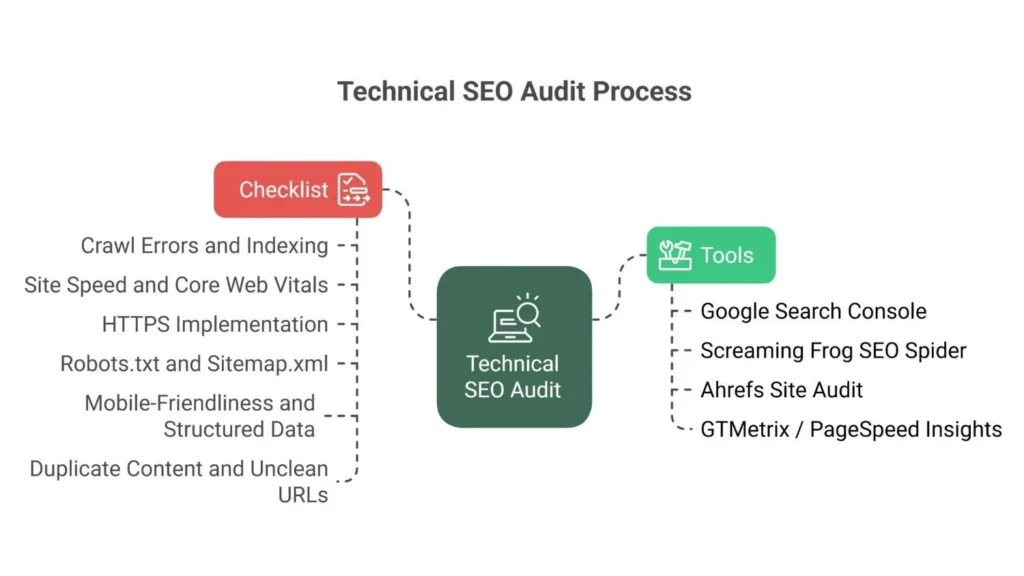
A technical SEO audit helps you uncover hidden issues affecting your site’s performance. It’s essential for ongoing optimization.
Tools to use:
- Google Search Console
- Screaming Frog SEO Spider
- Ahrefs Site Audit
- GTMetrix / PageSpeed Insights
Checklist:
- Check crawl errors and indexing status
- Evaluate site speed and Core Web Vitals
- Verify HTTPS implementation
- Review robots.txt and sitemap.xml
- Test mobile-friendliness and structured data
- Fix duplicate content and unclean URLs
Structured Data You Should Add to Every Business Website
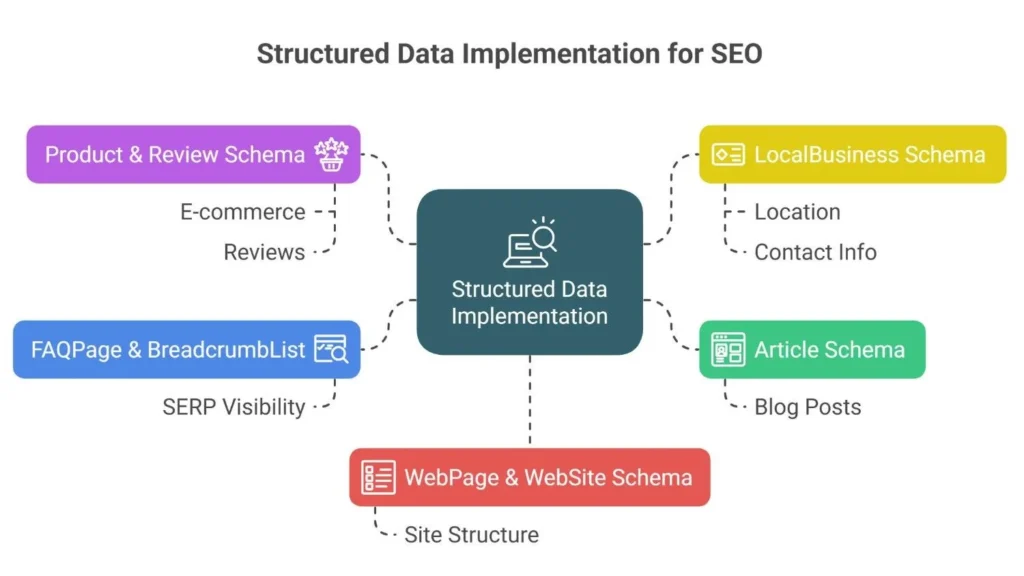
To enhance your website’s visibility in search results:
- Use Article schema for blog posts
- Use Product and Review schema for e-commerce
- Apply LocalBusiness schema with location and contact info
- Add FAQPage and BreadcrumbList for better SERP visibility
- Implement WebPage and WebSite to define the site structure
Geo SEO and Local Technical Optimization Tips
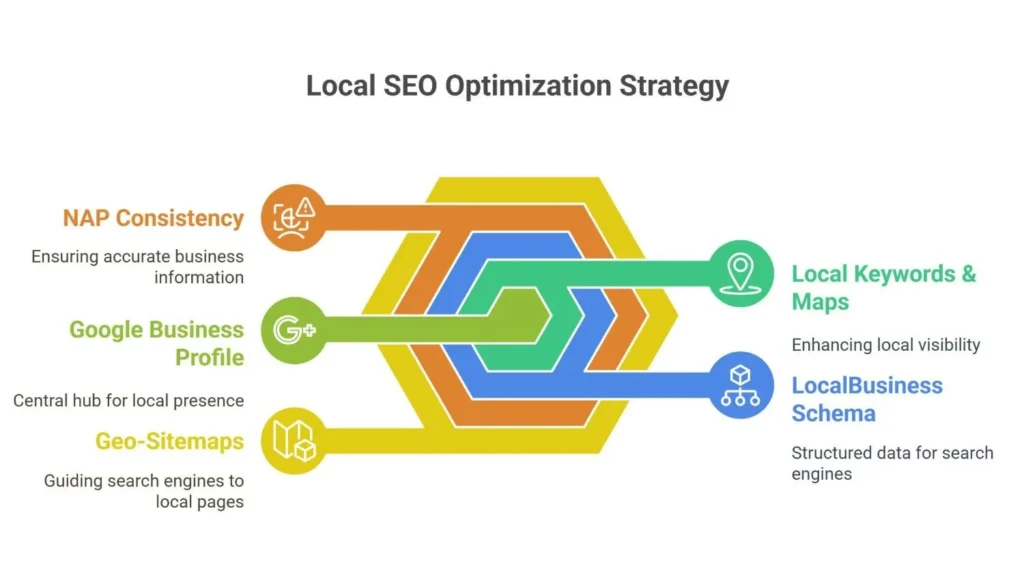
For businesses targeting local customers:
- Create and verify your Google Business Profile
- Embed maps and use local keywords on landing pages
- Use the LocalBusiness schema with geo-coordinates
- Ensure consistent Name, Address, Phone (NAP) across listings
- Submit geo-sitemaps for city-specific URLs in Search Console
What are technical SEO issues?
They are backend problems that affect your site’s visibility in search engines, including slow speed, poor structure, and crawl errors.
How do I fix technical SEO errors on my website?
Conduct an SEO audit using tools like GSC, Screaming Frog, and Ahrefs. Fix broken links, add schema, and optimize speed and mobile usability.
Is technical SEO different from on-page SEO?
Yes. Technical SEO focuses on infrastructure and crawlability, while on-page SEO deals with content and meta data.
How often should I do a technical SEO audit?
Conduct a technical SEO audit quarterly, or monthly for large, frequently updated websites to maintain performance and search visibility.
Does technical SEO affect Google ranking?
In a word, yes. Google uses signals including mobile friendliness, security, speed, and structured data as ranking factors.
Final Thoughts
Final Verdicts
Technical SEO is an ever-evolving process, not a one and done deal. When you are able to accurately identify and tackle issues like broken links, bad data management and a poor mobile experience, you’ll ensure better visibility, improved search results, and a much smoother journey for your users.
To get lift on algorithm updates and in competitive movements, establish a partnership with an experienced technical SEO consultant or agency that can deliver in-depth audits, data-backed implementation, and ongoing optimization around your business goals.








